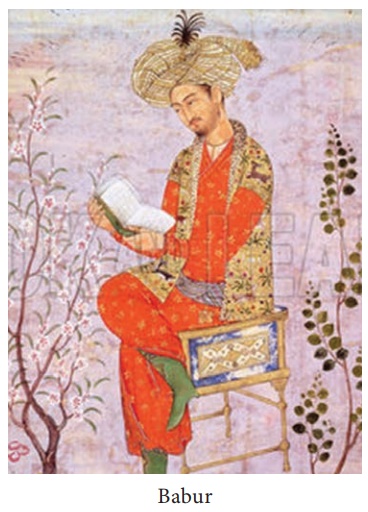The Mughal Empire - Zahiruddin Muhammad Babur (1526ŌĆō1530) | 11th History : Chapter 14 : The Mughal Empire
Chapter: 11th History : Chapter 14 : The Mughal Empire
Zahiruddin Muhammad Babur (1526ŌĆō1530)
Zahiruddin Muhammad Babur
(1526ŌĆō1530)
The race for political supremacy in Central Asia
amongst the Uzbeks (Turkic ethnic group), the Safavids (the members of the
dynasty that ruled Iran patronising Shia Islam) and the Ottomans (Turkish
people practicing Sunni Islam) forced Zahiruddin Muhammad Babur, the ruler of
Samarkand, to seek his career prospects elsewhere. Historically the trade
conducted by countries of Central Asia through the Silk Route with India had
provided the required knowledge about the country (India) they were interested
in. Babur who dreamed of repeating what Timur had done a century and a quarter
earlier, succeeded in founding the Mughal kingdom with Delhi as its capital in
1526 in the wake of the political disintegration of the Delhi Sultanate.

Babur, a boy of eleven, inherited the throne of
Samarkand (now a city in Uzbekistan) from his father. As there were enemies all
round him, he lost his throne but soon reclaimed it. But soon he realized that,
with the powerful Safavid dynasty in Iran and the Uzbeks in Central Asia, he
should rather turn to the southeast towards India to build an empire of his
own. As a Timurid, B─übur had an eye on the Punjab, part of which had been
TimurŌĆÖs possession. Between 1519 and 1524 when he invaded Bhera, Sialkot and
Lahore, he showed his definite intention to conquer Hindustan, where the
political scene also favoured his adventure. After conquering Kabul and Ghazni,
Babur crossed the Indus to India and established a small kingdom. The time for
invading India was also ripe as there was discontent among the Afghans and the
Rajputs, as Sultan Ibrahim Lodi of the Lodi dynasty was trying to expand his
territory. Babur received an embassy from Daulat Khan Lodi, a principal
opponent of Ibrahim Lodi, and Rana Sangha, ruler of Mewar and the chief of
Rajput Confederacy, with a plea to invade India. When Babur marched to India he
first defeated the forces of Daulat Khan Lodi at Lahore as he had gone back on
his promise to help Babur.
First Battle of Panipat, 21 April 1526
Babur then turned towards the Lodi-governed Punjab.
After several invasions, he defeated the formidable forces of Ibrahim Lodi with
a numerically inferior army at Panipat. Babur won this battle with the help of
strategic positioning of his forces and the effective use of artillery. BaburŌĆÖs
victory provided hopes for him to settle in India permanently. Babur had
conquered Delhi and Agra, but he still had to suppress the Rajputs and the
Afghans.
Artillery is an army unit that uses
large cannon-like weapons, transportable and usually operated by more than one
person. Gun powder was first invented by the Chinese and found its way to
Europe in the 13th century A.D. (CE). It was used in guns and cannons from the
mid-fourteenth century onwards. In India we have no instances of artillery being
used in war before Babur.
Battle of Khanwa, 1527
Babur decided to take on Rana Sanga of Chittor, who
as ruler of Mewar, had a strong influence over Rajasthan and Malwa. Babur
selected Khanwa, near Agra, as a favourable site for this inevitable encounter.
The ferocious march of Rana Sanga with a formidable force strengthened by
Afghan Muslims, Mahmud Lodi, brother of Ibrahim Lodi, and Hasan Khan Mewati,
ruler of Mewat, confronted the forces of Babur. With strategic positioning of
forces and effective use of artillery, Babur defeated Rana SangaŌĆÖs forces. This
victory was followed by the capture of forts at Gwalior and Dholpur which
further strengthened BaburŌĆÖs position.
Battle of Chanderi, 1528
The next significant battle that ensured BaburŌĆÖs
supremacy over the Malwa region was fought against Medini Rai at Chanderi.
Following this victory Babur turned towards the growing rebellious activities
of Afghans.
Battle of Ghagra, 1529
This was the last battle Babar fought against the
Afghans. Sultan Ibrahim LodiŌĆÖs brother Mahmud Lodi and Sultan Nusrat Shah,
son-in-law of Ibrahim Lodi, conspired against Babur. Realising the danger Babar
marched against them. In the battle that ensued along the banks of Ghagra, a
tributary of Ganges, Babur defeated the Afghans. But he died on his way from
Agra to Lahore in 1530
There is a story about BaburŌĆÖs death.
His son Humayun was ill and Babur in his love for him is said to have prayed,
offering his own life if his son got well. Humayun recovered.
Estimate of Babur
Babur, the founder of Mughal Empire, was a scholar
of Persian and Arabic. BaburŌĆÖs memoirs Tuziuk-i-Baburi
(Baburnama) is considered a world classic. Babur found nothing admirable
either in the Afghans who ruled India for some time or in the majority of the
people they governed. But his description of India is delightful.
What Hindustan possessed, in BaburŌĆÖs view, is
described as follows: ŌĆśThe chief excellence of Hindustan is that it is a large
country and has abundance of gold and silver. Another convenience of Hindustan
is that the workmen of every profession and trade are innumerable and without
end.ŌĆÖ
BaburŌĆÖs dominions were now secure from Kandah─ür to
the borders of Bengal. However, in the great area that marked the Rajput desert
and the forts of Ranthambhor, Gwalior and Chanderi, there was no settled
administration, as the Rajput chiefs were quarrelling among themselves. So
Babur left a difficult task for his son Humayun.
Related Topics